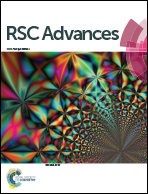Room temperature lead-free relaxor–antiferroelectric electroceramics for energy storage applications†
Abstract
Round the globe, scientific communities have been searching for new materials for “green” energy, producing efficiently both high power as well as high energy density. Relaxor ferroelectrics (RFEs) have shown immense potential to achieve this goal. We report fabrication of [Na0.42Bi0.44Al0.06Ba0.08)TiO3 (NBAT–BT)], a lead-free-relaxor antiferroelectric ceramic, via a conventional solid-state reaction method. A small fraction of trivalent cations (Al3+) doping at Na1+/Bi3+ sites develop anti-polar phase in the ferroelectric matrix which in turn changes its functional properties. Rietveld refinement suggests the existence of both tetragonal and rhombohedral phases which is well supported by d-spacing values obtained in high resolution transmission electron microscopy (HRTEM) studies. Elemental analysis confirms the stoichiometry of the system and matches the starting composition well within the experimental uncertainty (±10%) of secondary electron microscopy (SEM) and HRTEM data. Raman spectra suggest the substitution of Al3+ cation at an A-site sublattice. Temperature-dependent dielectric spectra show frequency dependent dielectric dispersion near 80–110 °C, high dielectric loss at high probing frequency, and a non-linear Vogel–Fulcher relation, substantiating the relaxor–antiferroelectric (r-AFE) nature of NBAT–BT. A second order diffuse anti/ferro-electric to paraelectric phase transition near 230–240 °C was observed which follows a modified Curie–Weiss law. The energy density was calculated from polarization–electric field (P–E) loops and dielectric–electric field (ε–E) plot. The values were in the range of 0.4–0.6 J cm−3, which is reasonably good for bulk polar material. NBAT–BT shows a much thinner AFE hysteresis above its relaxor FE phase transition; that favors the enhanced energy storage capacity at elevated temperature in the depolarized paraelectric region.


 Please wait while we load your content...
Please wait while we load your content...